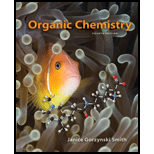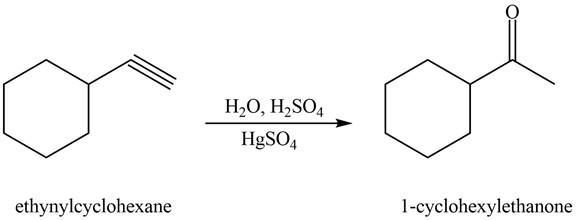
Concept explainers
What

(a)
Interpretation: The alkynes that forms the given ketone as the only product after hydration with
Concept introduction: A terminal alkyne reacts with
Answer to Problem 11.40P
The alkynes that forms the given ketone as the only product after hydration with
Explanation of Solution
The alkynes that forms the given ketone as the only product after hydration with

Figure 1
The terminal alkynes,
The alkynes that forms the given ketone as the only product after hydration with
(b)
Interpretation: The alkynes that forms the given ketone as the only product after hydration with
Concept introduction: A terminal alkyne reacts with
Answer to Problem 11.40P
The alkyne that forms the given ketone as the only product after hydration with
Explanation of Solution
The alkyne that forms the given ketone as the only product after hydration with

Figure 2
The terminal alkyne, ethynylcyclohexane reacts with the reagents
The alkyne that forms the given ketone as the only product after hydration with
(c)
Interpretation: The alkynes that forms the given ketone as the only product after hydration with
Concept introduction: A terminal alkyne reacts with
Answer to Problem 11.40P
The alkynes that forms the given ketone as the only product after hydration with
Explanation of Solution
The alkynes that forms the given ketone as the only product after hydration with

Figure 3
The terminal alkynes,
The alkynes that forms the given ketone as the only product after hydration with
(d)
Interpretation: The alkynes that forms the given ketone as the only product after hydration with
Concept introduction: A terminal alkyne reacts with
Answer to Problem 11.40P
The alkynes that forms the given ketone as the only product after hydration with
Explanation of Solution
The alkynes that forms the given ketone as the only product after hydration with

Figure 4
The terminal alkynes,
The alkynes that forms the given ketone as the only product after hydration with
Want to see more full solutions like this?
Chapter 11 Solutions
Connect Access Card For Organic Chemistry
- Draw structures for the products formed in the following reactions. If more than one product is possible, show all of them, and indicate the major product, if any.arrow_forwardWhat organic product would you obtain from reaction of 1-pentanol with CrO3, H2O, H2SO4?arrow_forwardOChem help... Provide the bond line structures of the reactants and the products formed in the following reactions and classify the product obtained as hemi-ketal, ketal, hemi-acetal, or acetal:arrow_forward
- 1. Predict the elimination products of the following reactions. When two alkenes are possible, predict which one will be the major product. Explain your answers, showing the degree of substitution of each double bond in the products. 2. Which of these reactions are likely to produce both elimination and substitution products? (a) 2-bromopentane +NaOCH3 (b) 3-bromo-3-methylpentane +NaOMe(Me= methyl, CH3) (c) 2-bromo-3-ethylpentane +NaOH (d) cis-1-bromo-2-methylcyclohexane +NaOEt (Et= ethyl, CH2CH3)arrow_forwardPlease help with the following... Draw the bond line structured for the reactants and the products obtained in the following reactions: 1. m-tertbutyl benzoic acid + 3-methyl-1butene, HF 2. 3-chloro-2,6-dinitrotulene + sodium ethoxide, ethanol 3. o-methylanisole + isobutanol, BF3arrow_forwardwhich of the following alkenes will most likely undergo a hydride shift when reacting with HCl?arrow_forward
- name and draw the product/s formed from the reaction of 3-methylpent-2-ene: 1. with HBr 2. with Cl2 3. H2O in the presence of H2SO4 4. ethanol in the presence of H2SO4 5. Br2, H2O 6. [1] 9-BBN; [2] H2O2, OH-arrow_forwardDraw a structural formula for the alkene with the molecular formula C5H10 that reacts with Br2 to give each product.arrow_forwardGive the product and mechanism for the following reaction. Be sure to include all mechanism arrows, lone pairs, and formal charges in your mechanism. The product is an alkene.arrow_forward
- Write structural formulas for the major organic product(s) formed by reaction of 1-methylcyclohexene with oxidizing agent. Q.) O3 followed by (CH3)2Sarrow_forwardWrite reactions of 2-methylbutene-2 with the following reagents: a. KMnO4/ H2O/20 °C; b. HBr.arrow_forwardReaction of hex-3-ene with MCPBA in CH2Cl2 will yield _________. an alkane an alkyne an aldehyde a ketone an epoxidearrow_forward
 Organic ChemistryChemistryISBN:9781305580350Author:William H. Brown, Brent L. Iverson, Eric Anslyn, Christopher S. FootePublisher:Cengage Learning
Organic ChemistryChemistryISBN:9781305580350Author:William H. Brown, Brent L. Iverson, Eric Anslyn, Christopher S. FootePublisher:Cengage Learning

